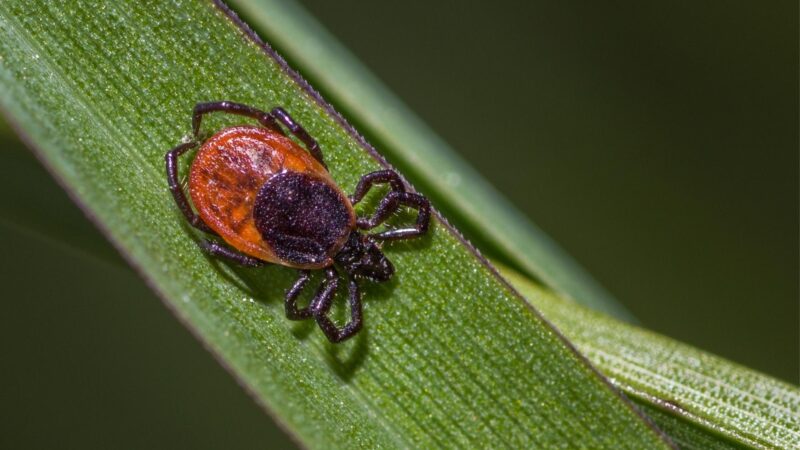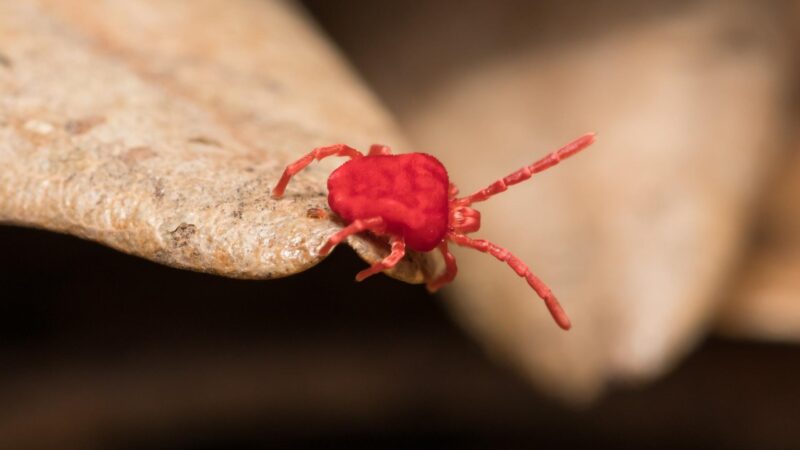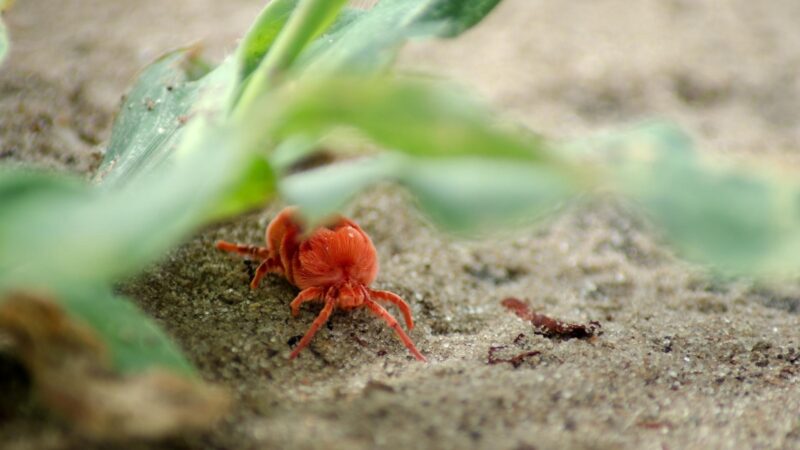Tiny red bugs are nuisance pests that infest houses in large numbers. Nonetheless, they’re not harmful to humans as they don’t feed on blood but plants.
When crushed, these red bugs will create a red stain in places where it was pressed.
What are these tiny red bugs? Tiny red bugs are true mites, closely associated with spiders and ticks. They’re small and are also known as clover mites. These are household pests that invade homes in large numbers, particularly during the spring and fall months.
In this article, you will know more about these tiny nuisances, including things they do to humans and ways to get rid of them naturally. So, let’s get right into it!
Table of Contents
Are These Red Bugs Dangerous?

Red bugs aren’t dangerous to humans, pets, or structures. But, these nuisance pests can be hard to eradicate, leading to a large infestation.
- These mites are small and hard to seal out.
- They get into wall gaps and other areas challenging to get at and treat.
- Clover mites are tough to control with any chemicals safe to use in a house.
- DIY control for clover mites usually leads to persistent frustration and damaged items as they’re hard to manage.
What Are Clover Mites?

If you’re constantly seeing tiny red bugs around your home, there is a chance that they are clover mites, which have a size of less than 1mm.
Their size makes them hard to spot until they have clustered up in large numbers. Clover mites are arachnids closely related to spiders and ticks.
What sets these mites apart from spiders and ticks is their feeding practices. They don’t feed on human or insect blood, but instead, they eat grass, clover, and other plants.
Moreover, they’re well-known for gathering in large numbers, notably in sunny locations, such as along your siding or porch.
If there is one thing clover mites are good at, it’s sneaking through small cracks and crevices. As they assemble around your house, they’ll enter through small spaces or gaps. Most often, professional pest control is required to eradicate these pests.
What Do Clover Mites Look Like?
Clover mites are microscopic insects, often referred to as tiny red bugs. The adult mites are reddish to brown, while the eggs and immature mites are a bright red.
These mites have eight legs, with two at their head, often thought of as antennae, since they can’t be seen well without a magnifying glass. To the naked eye, clover mites look like dark spots that are moving around the doors, walls, and windows.
Are Clover Mites Dangerous?
These nuisance pests are not dangerous to pets or humans since they don’t feed on blood like other mite species. However, they tend to intrude on houses in large numbers and leave stains when crushed.
What Do Clover Mites Do to Humans?
Clover mites don’t induce any health-related problems to humans like dust mites. Nevertheless, clover mites can cause skin irritation to people who are allergic.
Do Clover Mites Bite Dogs?
Clover mites are only known to damage belongings. They don’t bite dogs or any other pets as they don’t feed on blood.
Since these mites are so tiny, it may not be possible to recognize them until they spread in your house in great numbers.
What Do Clover Mites Hate?

Clover mites hate several household items, including peppermint oil, boric acid, liquid dish soap, vinegar, diatomaceous earth, and baby powder. They found these items irritant, causing them to steer away from your property.
What Are Clover Mites Attracted To?
Clover mites are attracted to moisture and over-fertilized lawns. When the wood outside your house is rotting or wet, they will use the condition to squeeze themselves to get into your property.
How to Prevent and Eliminate Clover Mites Naturally?
As the saying goes—prevention is always better than cure. So, to prevent having clover mites within your surroundings, consider doing the following:
Never Over-Fertilize Your Lawn
Clover mites are drawn to well-fertilized lawns, so make sure that you’re not adding an excessive amount of fertilizer to your yard.
To do that, always stick to the manufacturer’s guidelines regarding application rate and frequency.
Place Your Plant Properly
When setting plants in your yard, make sure not to put them too close to your home. This is because it will enable them to crawl from vegetation onto your house quickly.
It would be beneficial to leave at least a two-foot space between your home’s foundation and plants.
Create a Barrier
Another way of ensuring that no clover mites would like to enter your space is by creating a barrier of wood chips and gravel. Clover mites prefer to crawl on plants and are less likely to steer on other materials.
Seal Cracks and Gaps
To prevent clover mites from entering your home, make sure to examine your place for cracks and gaps where these mites enter. Once you’ve found them seal them right away.
It’s best to pay much closer attention to areas near the doors, windows, and your home’s foundation.
However, if you already have existing clover mites problems, you can get rid of them naturally using the following household items:
Peppermint Oil
The strong scent of peppermint oil deters many insects, including the clover mites. To apply:
- Drench cotton balls in peppermint oil.
- After that, leave them close to both the entry and exit points, doors, windowsills, etc., to help prevent any clover mites from penetrating your home.
Liquid Dish Soap
Liquid dish soap is another popular natural pest control approach many people use at home to kill and manage clover mites. To use:
- Mix a few drops of liquid laundry detergent or dishwashing soap in water and put it in a spray bottle.
- Once done, spray the solution over the clover mites. This will suffocate and eliminate them almost instantly.
- After that, remove clover mites using a microfiber cloth or a vacuum cleaner.
Note: Make sure not to crush them to avoid leaving red smears behind.
Boric Acid
Laundry detergents, such as Borax have a boric acid ingredient, which is a chemical compound that can repel and exterminate clover mites. To use:
- Sprinkle boric acid on areas where you believe have clover mites.
Vinegar
Vinegar is highly acidic, so it’s not a surprise clover mites hate this household item. To use:
- Mix white vinegar with water in a clean spray bottle and spray it straight into the clover mites or any affected areas.
- You can also spray the solution on your lawn to kill any clover mites concealing in the grass.
Note: Since vinegar is acidic, it’s best to test the solution first on a small area before spraying it on the whole lawn.
Diatomaceous Earth
Diatomaceous earth (DE) is an all-natural mite repellent. Choose food-grade since it’s safe to use. All you have to do is sprinkle it in strategic locations close to your home or garden.
Do Clover Mites Go Away on Their Own?
Fortunately, clover mites eventually perish out in homes since there’s usually no plant life for them to consume, and they don’t feed on human or pet blood.
What Do Clover Mites Eat?

Clover mites get their nutrition from feeding on plant juices, such as common lawn plants, grasses, and clover. They often live on patios and rooftops, where mildew or mold furnish food sources.
Where Do Clover Mites Lay Eggs?
Clover mites typically lay eggs in sidewalk cracks, building walls cracks, and other dry, concealed areas. Clover mites population can grow relatively quickly as females can lay up to 70 eggs, which only takes 30 days to mature.
Do Clover Mites Crawl on Humans?

Clover mites can crawl on humans, but they don’t cause any health issues or bite humans. However, they can irritate those who are allergic.
Can Clover Mites Get In Your Hair?
Clover mites can get into your hair and live there for around two weeks. They can transfer from host to host via hair follicles, including sebaceous glands and eyelashes.
Summary
In general, clover mites don’t pose great problems to humans, pets, and structures, unlike other mite species. However, when they grow in large numbers, they can be a real nuisance and start to damage your belongings.
To avoid that, act right away and do the necessary things to do. You can consider using the methods listed above or call for a pest control professional if a large infestation happens.